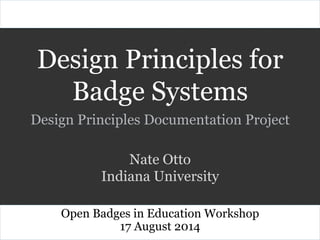
Nate Otto DPD Project Methods Presentation - Open Badges in Education Workshop
- 1. Design Principles for Badge Systems Design Principles Documentation Project Open Badges in Education Workshop 17 August 2014 Nate Otto Indiana University
- 2. Thanks to:
- 3. A METHOD FOR STUDYING DIGITAL BADGE SYSTEMS Design Principles
- 6. Design Principles Documentation Project Rebecca Itow Cindy Ahonen Katerina Schenke Cathy Tran Nate Otto Christine Chow Daniel T. Hickey Principal Investigator
- 9. Design Principles Documentation Project Goal: To find out how organizations are using digital badges in learning programs.
- 10. Design Principles Documentation Project Four functions of digital badge systems • Recognizing Learning • Assessing Learning • Motivating Learning • Studying Learning
- 11. Pulling apart different func1ons of badge systems.
- 12. Badge systems are collections of practices that serve a variety of functions.
- 13. Intended Practice Enacted Practice Formal Practice Evolution of a Practice Original design As first implemented Continuing practice
- 14. BUILDING BADGE SYSTEMS We studied programs that were
- 15. DESIGNING, ENACTING, AND FORMALIZING PRACTICES TO BUILD BADGE SYSTEMS We studied programs that were
- 16. Design Principles Documentation Project Four functions of digital badge systems • Recognizing Learning • Assessing Learning • Motivating Learning • Studying Learning
- 17. For each of these categories, we identified general design principles.
- 18. Sort Identified Practices Draft Initial Principles Formalize General Principles Bookmark Research Emergence of Badge Design Principles
- 20. Level badges Provide routes or pathways 1 General Principle 2 Specific Principles 18 practices across 30 projects (As implemented in project contexts) “Levels of Participation and Achievement” -Intel “Hierarchical Quest Paths” –NOAA Planet Stewards
- 21. General and Specific Principles: Recognizing Learning • Align badges to standards (23) – Use standards internal to community (3) – Use national or international standards (12) – Use community and national/ international standards (8) • Use badges to map learning trajectory (18) – Level badges (11) – Provide routes or pathways (7) • Have experts issue badges (15) – Credentialed via external accredited entity (8) – Credentialed via community (2) – Credentialed via accredited entity and community (5) • Seek external backing (15) – Externally endorsed (8) – Externally valued (7) • Recognize diverse learning (10) • Use badges as a means of external communica1on of learning (11) • Determine lifespan of badges (7) – Never expires (7) – Requires renewal or upgrading (0) • Recognize educator learning (7) • Award formal academic credit for badges (3) • Promote discovery (7) – Discover learning opportuniHes (5*) – Discover learners (2*)
- 22. Tracking principles across 3 phases Intended – Enacted – Formal
- 23. WHAT CAN WE LEARN? By identifying design principles
- 24. What projects have similar practices, even across different contexts?
- 25. What projects have similar practices, even across different contexts? Which principles were easy to enact? Which were hard? (Identify common challenges)
- 26. What projects have similar practices, even across different contexts? Which principles were easy to enact? Which were hard? (Identify common challenges) What contextual factors affected which principles were enacted?
- 27. Thank you for listening! Questions? http://dpdproject.info (for more info)
- 28. Nate O"o Project Coordinator Design Principles DocumentaHon Project Indiana University @o"onomy
